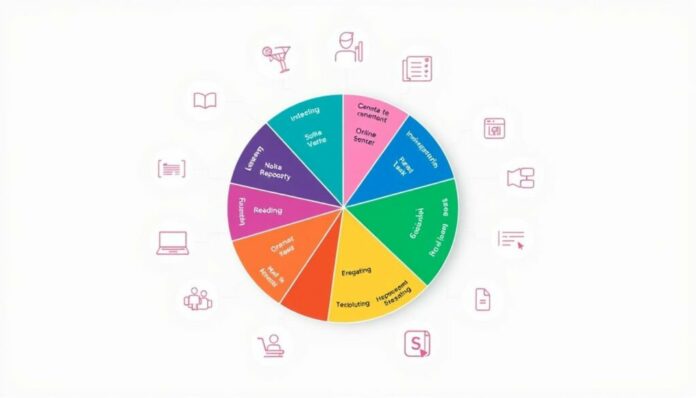In the world of affiliate marketing, success comes from segmenting your audience well. You need to send personalized content through your newsletters. Knowing your subscribers’ demographics, locations, interests, and behaviors helps you send messages that speak to them.
This article will show you how to segment your audience for better affiliate newsletters. By using customer data and analytics, you can make your content more personal. This approach boosts engagement, conversion rates, and your overall success in affiliate marketing.
Key Takeaways
- Understand the importance of targeted content for improved subscriber engagement and conversion rates
- Leverage demographic, geographic, psychographic, and behavioral data to segment your audience
- Utilize data analysis and customer insights to create personalized affiliate newsletter content
- Continuously test and refine your segmentation strategies for optimal performance
- Implement an ongoing process of optimization to ensure your affiliate newsletters remain relevant and effective
Introduction to Audience Segmentation
In the world of affiliate marketing, knowing your audience is key to success. Audience segmentation means breaking down your subscribers or customers into smaller groups. Each group shares similar characteristics. This way, you can make personalized content that speaks to each group, boosting customer engagement and higher conversion rates.
Understanding the Importance of Targeted Content
Segmenting your audience helps you create content that meets their specific needs. Unlike a one-size-fits-all approach, segmentation lets you customize your messages and products. This personal touch improves the user experience and strengthens your brand’s connection with your audience.
Benefits of Segmenting Your Audience
- Improved customer engagement and loyalty
- Higher conversion rates and sales
- Increased marketing efficiency and return on investment
- Deeper understanding of your audience’s preferences and behaviors
- Ability to develop more effective personalized content and campaigns
By using audience segmentation, you can open up many opportunities to boost your affiliate marketing success. It helps you better meet your audience’s needs.
Identifying Your Audience Segments
The first step in making audience segmentation strategies is to find the different groups in your subscriber list. You need to look at a lot of customer data collection to see patterns and similarities. This helps you understand your audience better.
Looking at demographic, geographic, psychographic, and behavioral data gives you a clear picture of your target market analysis. Knowing your customers well lets you make content that really speaks to each group.
Here are some ways to find your audience segments:
- Demographic Factors: Look at age, gender, income, education, and more to segment your audience.
- Geographic Location: Check where your subscribers live, like country, state, or city. This helps you tailor content to their local tastes and needs.
- Psychographic Traits: Dive into their interests, values, lifestyles, and attitudes. This helps you connect with them on a deeper level.
- Behavioral Patterns: Study their buying habits, how they engage, and what content they like. This shows you what drives them and how they make decisions.
| Segmentation Criteria | Examples |
|---|---|
| Demographic | Age, gender, income, education, occupation |
| Geographic | Country, region, city, urban/rural |
| Psychographic | Interests, values, lifestyle, personality traits |
| Behavioral | Purchase behavior, engagement, content preferences |
By carefully looking at these different data points, you can make a detailed audience segmentation strategies. This lets you send out affiliate newsletters that really speak to your audience.
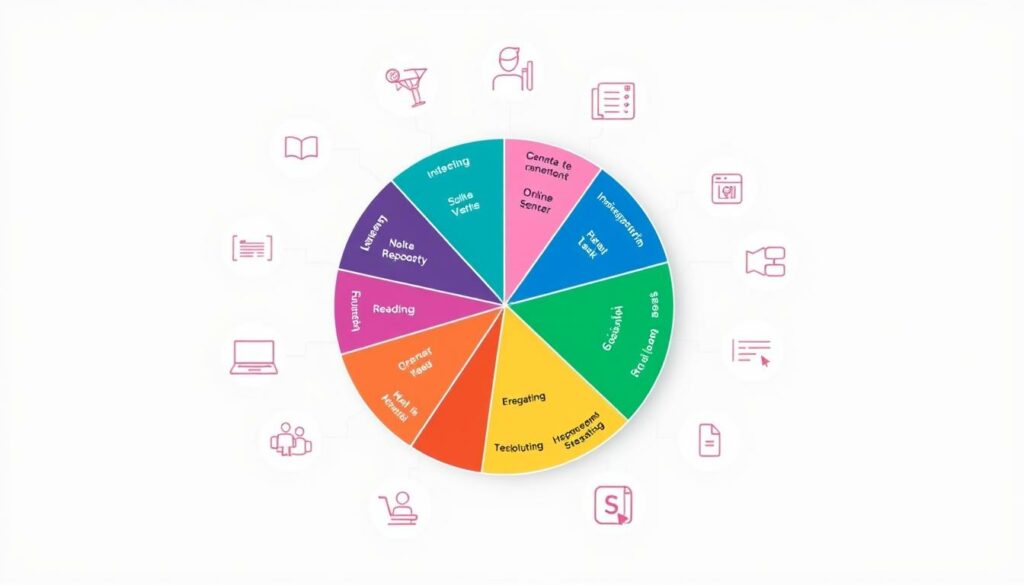

“The more you understand your audience, the more effectively you can communicate with them.” – Unknown
Demographic Segmentation Strategies
Effective affiliate marketing needs a deep understanding of your audience. It’s important to divide your subscribers by age, gender, income, and education. This way, you can make content and offers that speak to each group in your target market.
Age and Gender
Start by looking at the age and gender of your email list. Are most of your subscribers young adults, middle-aged, or retirees? Is there a balance between men and women? Tailoring your messages and product suggestions to these factors can boost engagement and sales.
Income and Education Levels
Understanding your subscribers’ income and education is also key. Are they high-earning executives, middle-class families, or college students? Knowing this helps you choose the right products and offers for each group.
| Demographic Segment | Targeting Strategies |
|---|---|
| Younger Audience (18-34) | – Use relatable, trendy language and imagery – Highlight new, innovative products – Emphasize social proof and peer recommendations |
| Higher Income ($75k+) | – Showcase premium, luxury products and services – Highlight exclusive offers and limited-time deals – Use more formal, aspirational messaging |
| College-Educated | – Provide in-depth, educational content – Emphasize thought leadership and expert insights – Use a more intellectual, analytical tone |
By analyzing your email list’s demographics, you can create content and offers that speak to each segment. This personal touch is crucial for higher engagement, conversions, and loyalty among your affiliate subscribers.
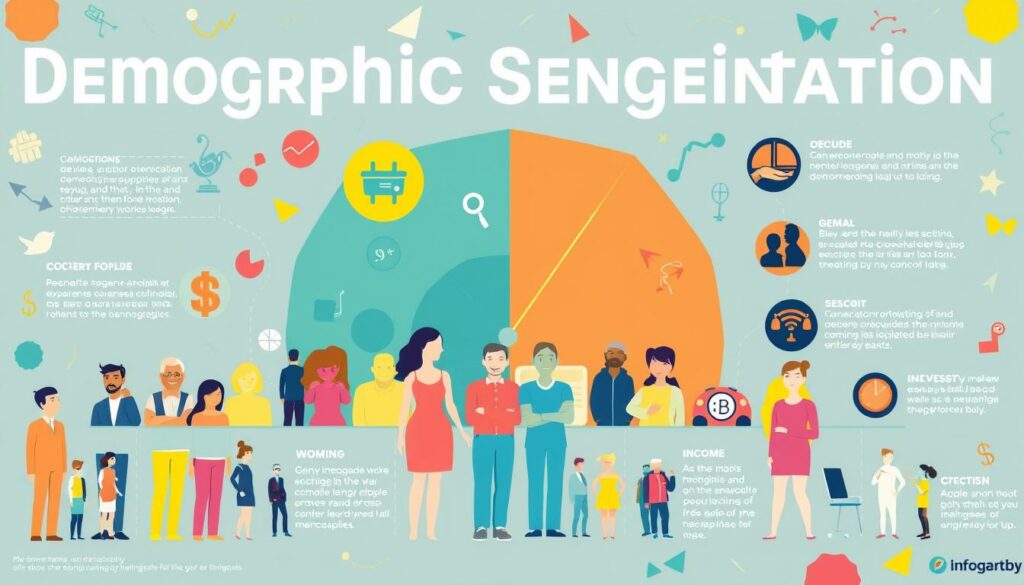

Geographic Segmentation Techniques
Targeting your affiliate newsletter audience with geographic segmentation is very effective. It divides subscribers by location, like country, state, or city. This way, you can make content that really speaks to each group.
Geographic segmentation lets you tailor your messages and offers to each region’s needs. For instance, outdoor gear affiliates might highlight different features for warm versus cold climates. Travel affiliates can show vacation packages that fit each location’s interests and budgets.
- Leverage location-based targeting to deliver personalized content and offers to your subscribers.
- Analyze regional trends and buying behaviors to inform your geographic segmentation strategy.
- Utilize regional marketing strategies to create tailored campaigns that resonate with local audiences.
Using geographic segmentation in your affiliate newsletter can greatly benefit your audience. It helps you understand and meet the diverse needs of your customers. This can significantly boost your engagement and conversion rates.
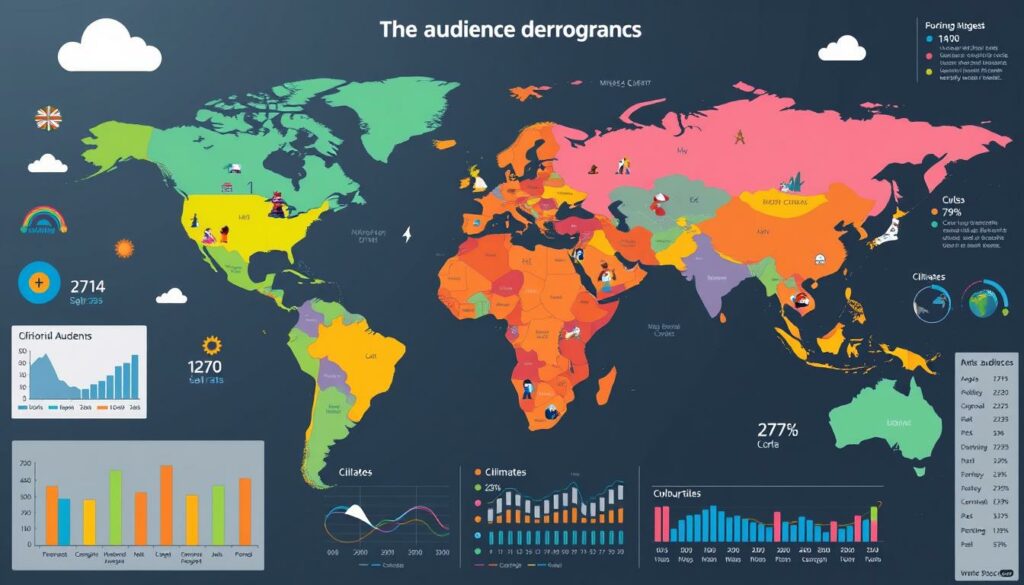

“Effective geographic segmentation is the key to delivering personalized content that resonates with your audience and drives meaningful results.”
Psychographic Segmentation Approaches
In the world of targeted marketing, psychographic segmentation is a powerful tool. It goes beyond demographics. By understanding your audience’s lifestyle, interests, values, and attitudes, you can create content that truly resonates with them.
Lifestyle and Interests
Psychographic segmentation lets you explore your subscribers’ activities, hobbies, and behaviors. Are they adventure-seekers, tech-savvy millennials, or health-conscious parents? Knowing their lifestyle preferences and interests helps you tailor your affiliate newsletters to their needs and desires.
Values and Attitudes
Understanding your audience’s beliefs, values, and mindsets is key. Are they socially conscious, environmentally aware, or prioritizing work-life balance? Knowing their core values and attitudes helps you craft messaging and offers that resonate emotionally. This builds stronger customer personas and fosters deeper connections.
By combining psychographic data with demographic and behavioral insights, you get a complete view of your audience. This holistic understanding lets you develop highly targeted affiliate newsletters. These newsletters captivate, engage, and drive conversions among your subscribers.
“Psychographic segmentation is a game-changer in the world of targeted marketing. It allows you to tap into the hearts and minds of your audience, crafting content that truly resonates with their interests, values, and lifestyle preferences.”
Behavioral Segmentation Methods
It’s key to know how your audience shops and spends. This helps you make your affiliate newsletters more targeted. By doing this, you can match your content better to what your subscribers like and need.
Purchase Behavior and Spending Habits
Looking at your audience’s purchase behavior shows you what they buy, how often, and how much. This info lets you suggest products that fit their spending habits better.
Also, studying their customer journey analysis gives you clues on what works best. You learn which content and offers lead to more sales. This helps you improve your behavioral segmentation and make your marketing more effective.
| Segmentation Approach | Key Metrics | Insights Gained |
|---|---|---|
| Purchase Behavior |
|
|
| Spending Habits |
|
|
| Customer Journey Analysis |
|
|
Using these behavioral segmentation insights, you can make your affiliate newsletters more personal and effective. This way, you can connect better with your subscribers and boost engagement and sales.
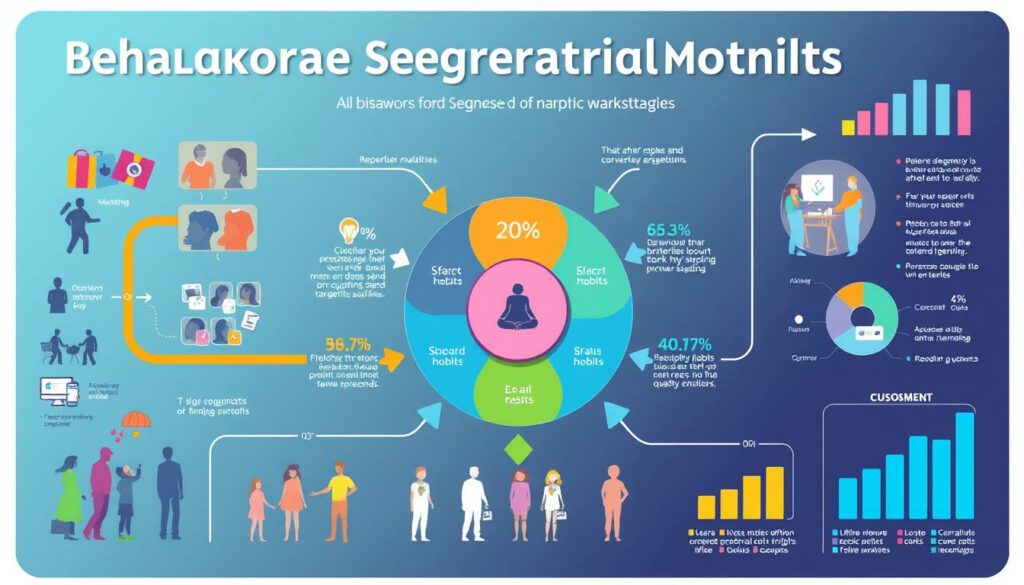

Segment your Audience Using Data Analysis
To segment your audience well, you need to know your customers deeply. This is possible through detailed data analysis. By using analytics and customer data, you can find important insights. These insights will help shape your affiliate newsletter strategies and guide your content creation.
Leveraging Analytics and Customer Data
The secret to good audience segmentation is in gathering and understanding data. You can get this data from website analytics, email marketing, and customer surveys. This information paints a picture of who your audience is, what they like, and how they behave.
- Analyze website traffic patterns to identify the most engaged user segments.
- Examine email open and click-through rates to understand your audience’s content interests.
- Conduct customer surveys to gather insights into their values, lifestyles, and pain points.
By mixing these data points, you can build a detailed audience profile. This lets you make analytics-driven marketing strategies that speak directly to each group.
| Data Source | Insights Gained | Segmentation Strategies |
|---|---|---|
| Website Analytics | Audience demographics, browsing behavior, content engagement | Demographic and behavioral segmentation |
| Email Marketing Metrics | Content preferences, purchase behavior, loyalty | Psychographic and behavioral segmentation |
| Customer Surveys | Interests, values, pain points, purchase motivations | Psychographic and behavioral segmentation |
By using audience segmentation data analysis and customer data utilization, you can make affiliate newsletters that really connect with your audience. This leads to more engagement, sales, and loyalty over time.
Creating Targeted Affiliate Newsletters
First, find out who your audience is. Then, make targeted affiliate newsletters that meet their needs. This means creating content, offers, and calls-to-action that fit each group’s unique traits and actions.
Crafting Personalized Content
Personalization is crucial for email marketing optimization. Tailor your newsletters to each audience segment’s interests and behaviors. This boosts engagement, conversion rates, and loyalty. Here are some tips:
- Use customer data and purchase history to suggest relevant products or services
- Include dynamic content that changes based on the subscriber’s location, browsing, or past interactions
- Make the subject line, greeting, and content personal to address the reader’s specific needs
- Segment your list and create custom content for each group, like different offers or calls-to-action
Using these personalized content creation strategies, you can send targeted affiliate newsletters that connect with your audience. This leads to more engagement and conversions.
“Personalization is the key to unlocking the full potential of your email marketing campaigns. By tailoring your content to the unique needs and interests of your audience, you can build stronger relationships and drive better business results.”
Creating effective personalized content means always testing and improving. Keep an eye on your email metrics, listen to customer feedback, and tweak your targeted affiliate newsletters to stay relevant and engaging.
Testing and Refining Your Segmentation Strategy
Audience segmentation is a never-ending journey. It needs testing and refinement all the time. By checking how your targeted affiliate newsletters do, you can spot areas to improve. Then, you can tweak your segmentation strategy to send the best content to your subscribers.
Email marketing optimization is a big part of this. Look at the open rates, click-through rates, and conversion rates of your newsletters. This tells you what content works best for each group. You can then use this data to pick the best content, subject lines, and calls-to-action for each segment.
Also, keep improving your segmentation by getting more detailed customer data. This could be browsing history, purchase records, and feedback. It helps you find new segments or make the ones you have better. This way, you can target your audience’s needs and likes more accurately.
| Metric | Segment A | Segment B | Segment C |
|---|---|---|---|
| Open Rate | 35% | 42% | 28% |
| Click-through Rate | 12% | 18% | 9% |
| Conversion Rate | 5% | 8% | 3% |
By always testing and refining your segmentation strategy, you make sure your affiliate newsletters are top-notch. This leads to more engagement, conversions, and money for your affiliate program.
Optimization and Continuous Improvement
Keeping a successful audience segmentation strategy alive means always working to improve. This includes regularly checking your subscriber data and trying out new ways to segment your audience. By doing this, you make sure your efforts keep paying off.
One crucial part of this is making decisions based on data. Watch how your segmented campaigns do in terms of engagement and sales. This helps you know what’s working and what’s not. Then, you can use this info to tweak your strategy and try new things.
It’s also key to keep testing and trying new ways to segment your audience. See how different criteria like demographics or interests affect your newsletters. By always looking for new ways to segment, you can find better ways to connect with your audience and get better results.
Success in audience segmentation comes from being ready to change and grow. Stay flexible, listen to what your customers want, and keep working to get better. This will help you stay ahead in affiliate marketing and make sure your subscribers always get the best content.
“Continuous optimization is the secret to sustained success in audience segmentation and targeted email marketing.”
Conclusion
In the world of affiliate marketing, segmenting your audience is crucial. It helps you reach your full potential with newsletter campaigns. By knowing what your subscribers like and do, you can make content that speaks to them.
Using audience segmentation best practices is key. This includes looking at demographics, where they are from, what they like, and how they behave. It lets you give them a personalized experience. This not only keeps them engaged but also makes your brand more trusted.
Keep working on your audience segmentation skills. Always test and adjust your strategies to meet your audience’s changing needs. By doing this, you can make your affiliate marketing campaigns more successful. And you’ll build stronger, more profitable relationships with your subscribers.
FAQ
What is the importance of audience segmentation for targeted affiliate newsletters?
Segmenting your audience is key for effective affiliate newsletters. It lets you tailor content to each group’s unique needs. This approach boosts engagement and conversion rates, making your campaigns more successful.
What are the benefits of segmenting your audience?
Segmenting your audience brings many advantages. It increases engagement, boosts conversion rates, and enhances affiliate marketing success. Personalized content meets specific needs, building stronger subscriber relationships and driving better results.
How can I identify different audience segments?
To find your audience segments, analyze demographic, geographic, psychographic, and behavioral data. Look at age, gender, income, location, interests, values, and buying habits. This helps uncover patterns and similarities among your subscribers.
What are some strategies for demographic segmentation?
Demographic segmentation divides your audience by age, gender, income, and education. Knowing your subscriber base’s demographics helps you create content that resonates with each group.
How can I leverage geographic segmentation techniques?
Geographic segmentation divides your audience by location, like country, state, or city. Understanding regional needs and preferences makes your affiliate newsletters more relevant and engaging for each group.
What is psychographic segmentation, and how can it benefit my affiliate marketing efforts?
Psychographic segmentation divides your audience by interests, values, attitudes, and lifestyle. Knowing your subscribers’ psychological drivers helps you create content that resonates deeply, boosting engagement and conversion rates.
How can I use behavioral segmentation to improve my affiliate newsletters?
Behavioral segmentation divides your audience by their actions and behaviors, like purchasing patterns. Understanding how subscribers interact with your content helps you tailor your newsletters to better meet their needs.
What role does data analysis play in audience segmentation?
Data analysis is crucial for effective audience segmentation. It involves collecting and analyzing data from various sources. This data helps you understand your audience’s characteristics and behaviors, enabling targeted and effective affiliate newsletters.
How can I create personalized content for my targeted affiliate newsletters?
After identifying your audience segments, create targeted affiliate newsletters. Craft personalized content, offers, and calls-to-action that resonate with each segment’s specific characteristics and behaviors.
How can I continuously improve my audience segmentation strategy?
Audience segmentation is an ongoing process. Analyze your affiliate newsletter performance to identify areas for improvement. Make adjustments to your strategy to ensure you deliver the most relevant and engaging content to your subscribers.

